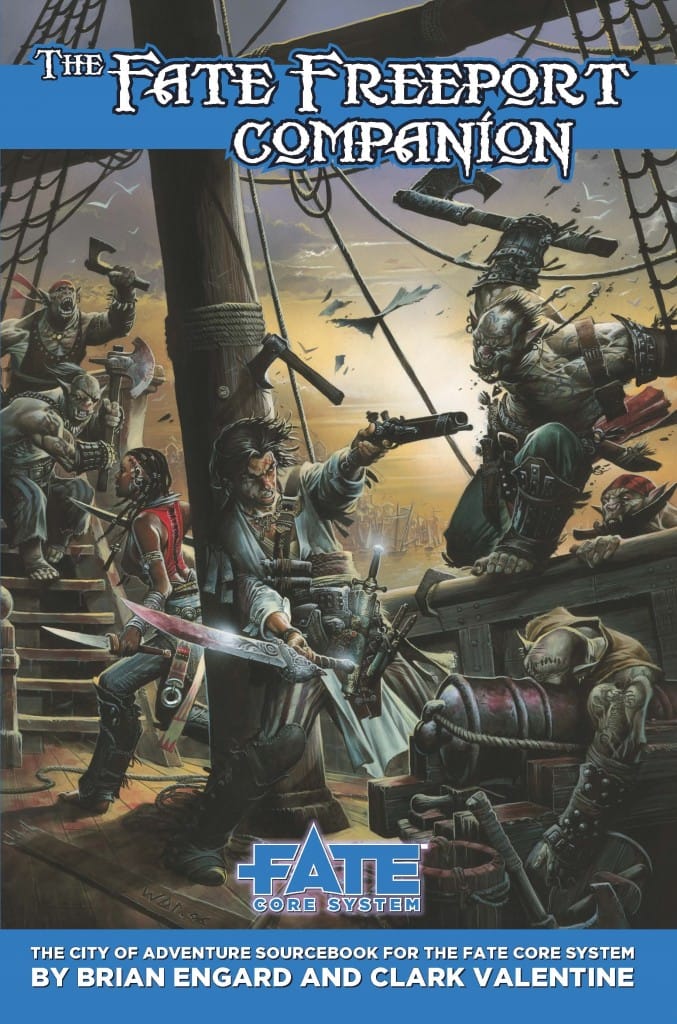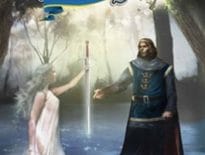 Blacksand, Babylon 5, Ankh Morpork, Mos Eisley…
Blacksand, Babylon 5, Ankh Morpork, Mos Eisley…
Sometimes, to say ‘Any Port in a Storm‘ is simply an uncomplicated fact. When life or the weather get choppy and you need to find somewhere to shelter or hide out, then a port will likely have all you need. Because all forms of life tend to end up in these places, they can get a bad name – all that ‘Wretched Hive of Scum and Villainy‘ malarky – but that’s just the way things go when a location serves as a passing point for anyone and everyone.
You can add Freeport to that list. A place of trade and commerce, privateers and pirates, slums and palaces… it serves as a nexus for friends and enemies, adventurers and patrons. And now you can take your Fate to town…
Form
The Fate Freeport Companion is a 190-page PDF (also available as a physical book from Evil Hat Productions), presented in a single column format. Written by Brian Engard and Clark Valentine, and published by Green Ronin Publishing.
The supplement contains plentiful illustrations of Freeport life, personalities and maps.
Features
Green Ronin have been developing the Freeport setting for more than a decade now, and one of the series innovations has been the introduction of Freeport Companions. Companions work alongside Freeport setting materials – like the Pirate’s Guide to Freeport – to allow you to use a game of your choice. This Companion uses Fate Core, one of the Kickstarter sensations of 2013.
The heart of Fate Core offers all you need to set up adventures and campaigns with your friends around the gaming table. A generic game with potential to flex to meet your needs – a concept often referred to as Dials, which allow you to adjust the presence and dominance of certain game facets like Stunts and Skills – Fate Core can go where you want it. To offer a specific setting or campaign framework, you or a publisher need to design a toolkit.
Toolkits specify the settings on the dials, the parts of the Core nudged into the background or zoomed into sharp focus. The Fate Freeport Companion is just such a toolkit, bending and flexing the Core rules to support and compliment the heart and soul of the setting.
The book breaks down into five Chapters and rounds off with an adventure, to bring it all together, Fury in Freeport.
Getting in Character
The first chapter handles character generation. In essence, Fate Core’s basic concepts stand, but Freeport emphasizes and tweaks a few key areas.
As Freeport exists in a fantasy world, players use Aspects and Stunts to highlight their heritage. If you just want to be an Elf, you select an Aspect like ‘Steadfast Warden Elf of the Amethyst Forest’ or maybe just ‘Wood Elf’ (though the GM might ply you for a little more detail to enable leverage in storytelling and Compels). However, if you’re keen for something a little more substantial, you use Stunts to round out the specific characteristics and abilities of your selection – like ‘Treetop Grace’ or ‘Sleepless Vigil of the Squawk Owl’.
The other change – a common Dial in the Fate Core toolkit – affects Skills. Freeport uses a standard set of just six Skills, a fraction of those listed in Fate Core. The Skills here echo the common characteristics of Dungeons & Dragons – namely, Strength, Dexterity, Constitution, Intelligence, Wisdom and Charisma. The chapter offers examples of how a player can use these Skills to attack, defend, overcome and create advantage, as well as providing some example ‘packages’ for quick character creation. Effectively, this allows a GM or player to eyeball an existing character from an adventure written for D&D or similar, and rapidly generate a near equivalent based on the bonuses. Simplicity.
With Great Power
The second chapter deals with the other big concept for a fantasy game – magic. Like race, Freeport handles treatment of magic through Aspects and Stunts. If you merely dabble on the periphery of spellcraft, with a couple of tricks or cantrips to your name, an Aspect will suffice, otherwise you use Stunts. The chapter lists guideline stunts and aligns them with standard schools of magic. Having settled on a Stunt and chosen a School or two, you can then pick out some key spells – though the system aims to remain open, flexible and not codified with straitjacketing lists.
Spells work like mini-Stunts and require a cost and an action to cast. The simplest spells cost nothing and hardly compare to a standard Stunt, while the most powerful invocations demand not only a Fate Point or more to cast, but pre-requisites, temporary negative Aspects, and you can only use them once per session. The section includes nine pages of sample spells across ten different schools and types, which encompass both arcane and divine powers – as mechanically they’re the same thing. Many of the examples mimic common spells from classic fantasy roleplaying games to make it simpler for GM and player alike to understand the process of coming up with their own. At the same time, you have enough spells here to get you going if you just want to play a one-off or short adventure.
Freeport introduces the concepts of Corruption and Insanity as elements similar to the existing stress tracks in Fate Core. The setting has elements of the Lovecraftian about it, with cultists and elder gods, so these new mechanics support the slow degradation of the body and soul. Corruption uses a new stress track, while Insanity falls into the coverage of Mental Stress with specific triggers. It makes good sense, and I can see myself using Corruption as a facet of adapting Fate Core to other settings, like Warhammer or Lord of the Rings.
Tools of the Trade
Equipment serves as the focus for the third chapter. The section starts with weaponry, which falls into four categories – Martial, Heavy, Finesse and Ranged – or something combination therein. Each type subtly changes the way you interact with your opponent – like using Dexterity instead of Strength Skill for Finesse weapons, which depend on speed and manual dexterity instead of raging brute force.
A longer section covers black power weapons, from muskets to cannons; then armour rounds off the combat-related content for the chapter. As a fantasy setting, the section also briefly considers magic items, which loosely fall into the realms of Stunts, but often might be a narrative facet of the character or something gleaned by the expenditure of a Fate Point if a bit more potent.
All Creatures Great and Small
A bestiary fills the fourth chapter, kitting the GM out with a world of hurt to batter on the adventurer’s. The section includes 25 pages of creatures drawn from the Freeport setting, statted up for Fate Core, but more importantly starts off with sound guidance on how to convert creatures yourself.
The section includes numerous interesting, challenging, and sometimes scary creatures ready to fight your character group straight off the page or provide sound examples for converting something from your favourite game. So, while we have Freeport favourites like Burnlings and howling, chest-beating Blemmyae, you also have Zombies, Giants Lizards and wild Boars to give you some more commonplace creatures easily compared against those in your favoured system.
You Know That Scum and Villainy We Mentioned…
The final chapter, and the most substantial, recalls the fact that while we’re dealing with a fantasy world, we’re focussed on a specific urban setting. More precisely, we’re looking at Freeport.
Over 60 pages long, Chapter 5 provides more than 50 pages of named and fully statted personalities, and just over 10 pages of generic denizens of the fantasy urban sprawl. If you need beggars, muggers, cultists, or pirates, look no further – for you will find them here, listed in Apprentice and Journeyman varieties. Each includes key Aspects, Skills and Attacks, along with a brief explanation for the more obscure types like Lobstermen – a secret organisation of scavengers – and The Syndicate – a rough gang of street-dwellers, crooks and heavies.
The personalities consume between a half page to a full one, many with illustrations. Each descriptions includes a quote, rumour, or character assassination of the personality, followed by a suitably detailed overview role, motivations, Aspects, Skills, Stunts, Gear and attacks. Some minor, supporting personalities, other more potent and influential individuals, you have more than 80 to draw upon to colour your adventures in Freeport.
Of course, as well as colour, each also has Aspects and Stunts for you to read through and consider, reinforcing the earlier advice on how best to use these in recreating assets and elements of the fantasy Freeport setting. A thin scattering of personalities would have been a disappointment, but that isn’t a concern to be had here with the selection offered.
Fury in Freeport
To round off the Companion, ‘Fury in Freeport’ provides adventure designed to introduce new players and/or characters to the settings and, potentially, serve as starting point for a campaign.
The characters receive what seems like a reasonably easy commission for a bit of light burglary at the Municipal Auction House. However, nothing simple ever goes to plan, so after an unexpected turn of events, more security than expected and a scuffle with something decidedly inhuman, the characters find themselves embroiled in something altogether more complex and dangerous. Unable to find the item they were after, they nevertheless come under scrutiny as the party most likely to have it – and then accusations of murder follow. The characters must find the item, find the culprit, and clear their names.
The adventure includes full stats for all the various personalities and adversaries involved, as well as maps for all the key locations. Investigation sections includes various rumours and hearsay. Key features introduced to Fate Core to support the Freeport setting all get an airing – so, Fury makes for an ideal start.
Final Thoughts
All in all, The Fate Freeport Companion packs a lot of interesting material into the page count, serving as a sweet spot to start fantasy adventuring with the generic Fate Core engine. While you need additional books, like the Pirate’s Guide to Freeport, to make optimum use of the Companion, the book contains enough ideas on Skills, spells, races and other features of fantasy roleplaying to kickstart a more generic game without anything more than the Fate Core book itself.
Highly recommended – and right now you can get Pirate’s Guide to Freeport and The Fate Freeport Companion as a Fate Freeport Bundle deal.

